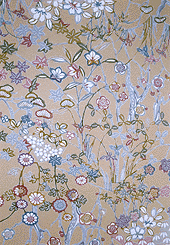 |

|
Kyo Komon (patterned kimono)
 This style, in which small patterned designs are dyed on a white cloth, is said to have fully developed by the late 16th century. A hemp kimono with small designs said to have been worn by dominal lord Uesugi Kenshin and a vest owned by hegemon Tokugawa Ieyasu can still be seen. Even in the Edo period, patterned kimono, which were ranked next in line to family crested kimono of the warrior class, could be worn only by those with social status. They were used as old ceremonial dresses with a specific, decided pattern. There was even a time when its use was prohibited to the commoner, however, in later times, it became wide spread among the general public. Although it originally developed with subtle, delicate monochrome designs, in the Meiji period, as tastes changed and scientifically produced dyes were imported, multi-colored patterns and designs came to be used. Moreover, Kyoto's komon were influenced by Yuzenzome (printed silk) and developed a distinct flavor. This style came to be known for its influence on as well as influence from Yuzenzome and for its picturesque and colorful designs. This style, in which small patterned designs are dyed on a white cloth, is said to have fully developed by the late 16th century. A hemp kimono with small designs said to have been worn by dominal lord Uesugi Kenshin and a vest owned by hegemon Tokugawa Ieyasu can still be seen. Even in the Edo period, patterned kimono, which were ranked next in line to family crested kimono of the warrior class, could be worn only by those with social status. They were used as old ceremonial dresses with a specific, decided pattern. There was even a time when its use was prohibited to the commoner, however, in later times, it became wide spread among the general public. Although it originally developed with subtle, delicate monochrome designs, in the Meiji period, as tastes changed and scientifically produced dyes were imported, multi-colored patterns and designs came to be used. Moreover, Kyoto's komon were influenced by Yuzenzome (printed silk) and developed a distinct flavor. This style came to be known for its influence on as well as influence from Yuzenzome and for its picturesque and colorful designs.
BACK


|
|